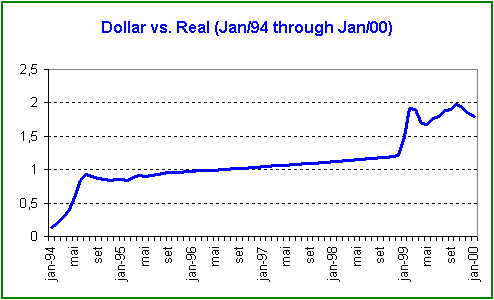Below, advertising
|
Dollar versus Real - 1994 to 1999

Click here to see the graphic from 1994 to 2005
The graphic shows the value of the Real against the dollar from January of 1994 to January of 2000.
On June 1st 1994, Brazil implemented one of the most important steps of Real Plan: the currency was changed. The old "cruzeiro real" was abandoned, and the new currency, Real (symbol R$) gained course.
As a symbolism to gain confidence, the Brazilian monetary authorities defined that, on launching, the Real would be equivalent to the dollar (R$ 1 = US$1). However, the equivalence should be maintained by fiscal and monetary measures, and not by force of law (shortly before, Argentina had launched Plan Austral, which defined, in the Argentinian Constitution, that the Austral would be legally pegged to the dollar).
In the first few months of existence, the new currency caused a surprise to most Brazilians: it gained value against the dollar. This happened for some reasons: the Central Bank increased interest rates; there was liquidity in the international markets; most important of all, foreigner investors believed in the success of the Plan Real, which would (with the fall of inflation) cause redistribution of income, and Brazil saw a massive influx of foreigner investments.
The devaluation of the dollar had a negative impact on Brazilian exporters, and was subject of hot discussions within the government of then President Fernando Henrique Cardoso. Important Ministers, like future candidate to Presidency José Serra, defended that the real should be devalued (at least back to the point of US$1 = R$1), to avoid damages to foreign trading.
In 1995, the Mexican currency is attacked. The Brazilian government, which until then had let the Real float, decided to take measures to control the value of the currency, protecting it against fluctuations caused by speculators.
Then, stepped into the scene Gustavo Franco. One of the mentors of Real Plan, Franco started the government as the Director of International Operations of Central Bank, and later on, when Pérsio Arida resigned, Franco became President of Central Bank of Brazil.
Franco was the main responsible for the more than four years (from 94 to early 99) of controlled currency in Brazil. During the period, the dollar would be adjusted about 0.6-0.7% per month (7-8% per year). Brazil had the longest period of low inflation in its History; in several months, indexes were negative.
Franco´s policy had a tangible positive effect: the inflation was tamed. Brazilians had seen many economic plans fail before, and many believed that the Real would follow; only by maintaining inflation at low levels during several years, did the Real Plan manage to gain credibility among the economic agents.
This policy, however, had a high price. Because of the weak dollar, exporters lost markets, importers took over the shelves in supermarkets, Brazilians travelled abrod more than ever. In addition, in 1995/96 the FED continuously increased interest rates, reducing the financial liquidity of international markets; also, speculators started attacks against several weaker currencies (currencies in Southeast of Asian collapsed in June of 1997).
Still, Gustavo Franco refused to devaluate the Real; Franco said that the basilar ideas of the Plan Real (strong Real, privatization, competition) should be kept, and would bring benefits in the long term.
The course of the dollar was determined by the Central Bank, which applied gradual devaluations; in occasions of speculative attacks against the Real, Franco would sell dollars at official rate and increase interest rates, to punish those who wouldn´t believe in the Real. As a result, during the period 1994/1999, Brazil saw the public debt surge, and the foreign commercial surplus turn into a huge deficit.
In October 1998, Brazil held elections and Fernando Henrique Cardoso was re-elected to Presidency; one of the main reasons of the prestige of FHC was the low inflation, and much of the low inflation was result of Franco and his policy.
In January of 1999, a new attack against the Real followed. The interest rates were again raised, but didn´t stop the attacks. Over a few days, the Central Bank had to sell tens of billions of dollars at official rate.
On January 13th 1999, the Government (President Cardoso and Minister of Finances Pedro Malan) decided that the protection of the Real was being too expensive, and that the Real should float freely. Many say that Cardoso and Malan delayed an inevitable action (the devaluation), with the only purpose of winning the elections in 1998.
In disagreement with the new policy, Franco resigns.
The new President of Central Bank, Francisco Lopes, tries to create a method by which the Real would float within a wide band. The market was stronger, though, and Lopes´ idea was crushed. In a few days, the dollar surged from around R$1.20 to R$2.15.
On March 4th 1999, Arminio Frago took office as new President of Central Bank. The very same day, Fraga increased interest rates from 25% to 45%.
In the following months, Fraga implemented a new monetary policy, based on floating currency and inflation target; this explains why, from 1999 on, the Real has been having a more erratic behave versus the dollar.
Read more about the Real versus dollar from 1999 to 2005.
Back to Top
|
|

